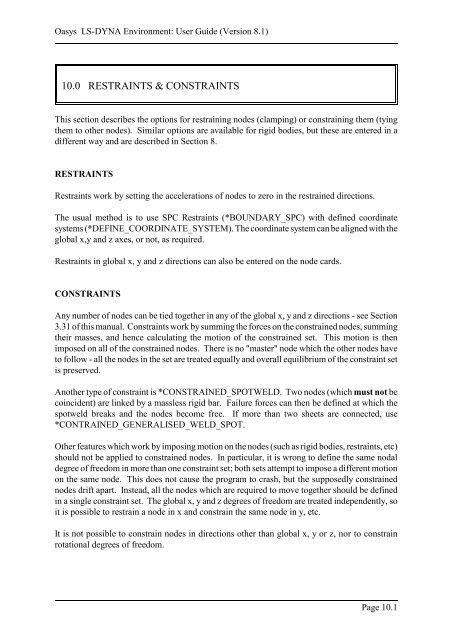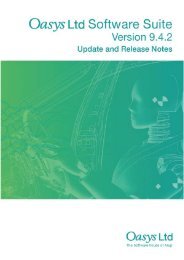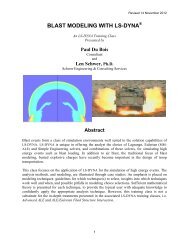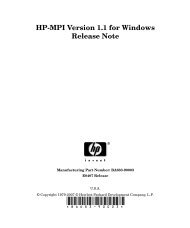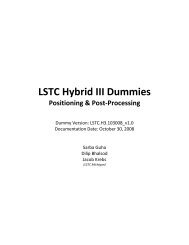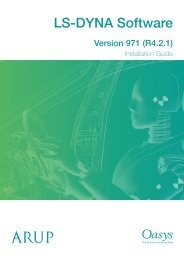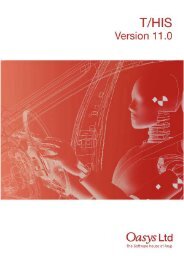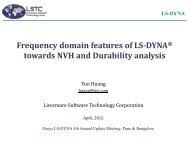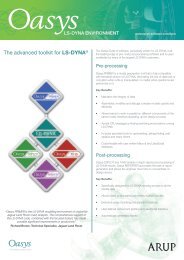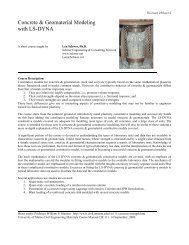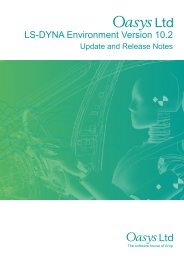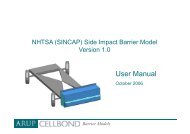Oasys LS-DYNA Environment 8.1 VOLUME 3 ... - Oasys Software
Oasys LS-DYNA Environment 8.1 VOLUME 3 ... - Oasys Software
Oasys LS-DYNA Environment 8.1 VOLUME 3 ... - Oasys Software
Create successful ePaper yourself
Turn your PDF publications into a flip-book with our unique Google optimized e-Paper software.
<strong>Oasys</strong> <strong>LS</strong>-<strong>DYNA</strong> <strong>Environment</strong>: User Guide (Version <strong>8.1</strong>)<br />
10.0 RESTRAINTS & CONSTRAINTS<br />
This section describes the options for restraining nodes (clamping) or constraining them (tying<br />
them to other nodes). Similar options are available for rigid bodies, but these are entered in a<br />
different way and are described in Section 8.<br />
RESTRAINTS<br />
Restraints work by setting the accelerations of nodes to zero in the restrained directions.<br />
The usual method is to use SPC Restraints (*BOUNDARY_SPC) with defined coordinate<br />
systems (*DEFINE_COORDINATE_SYSTEM). The coordinate system can be aligned with the<br />
global x,y and z axes, or not, as required.<br />
Restraints in global x, y and z directions can also be entered on the node cards.<br />
CONSTRAINTS<br />
Any number of nodes can be tied together in any of the global x, y and z directions - see Section<br />
3.31 of this manual. Constraints work by summing the forces on the constrained nodes, summing<br />
their masses, and hence calculating the motion of the constrained set. This motion is then<br />
imposed on all of the constrained nodes. There is no "master" node which the other nodes have<br />
to follow - all the nodes in the set are treated equally and overall equilibrium of the constraint set<br />
is preserved.<br />
Another type of constraint is *CONSTRAINED_SPOTWELD. Two nodes (which must not be<br />
coincident) are linked by a massless rigid bar. Failure forces can then be defined at which the<br />
spotweld breaks and the nodes become free. If more than two sheets are connected, use<br />
*CONTRAINED_GENERALISED_WELD_SPOT.<br />
Other features which work by imposing motion on the nodes (such as rigid bodies, restraints, etc)<br />
should not be applied to constrained nodes. In particular, it is wrong to define the same nodal<br />
degree of freedom in more than one constraint set; both sets attempt to impose a different motion<br />
on the same node. This does not cause the program to crash, but the supposedly constrained<br />
nodes drift apart. Instead, all the nodes which are required to move together should be defined<br />
in a single constraint set. The global x, y and z degrees of freedom are treated independently, so<br />
it is possible to restrain a node in x and constrain the same node in y, etc.<br />
It is not possible to constrain nodes in directions other than global x, y or z, nor to constrain<br />
rotational degrees of freedom.<br />
Page 10.1


